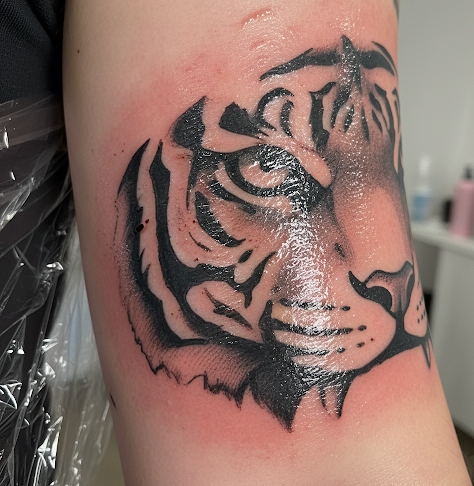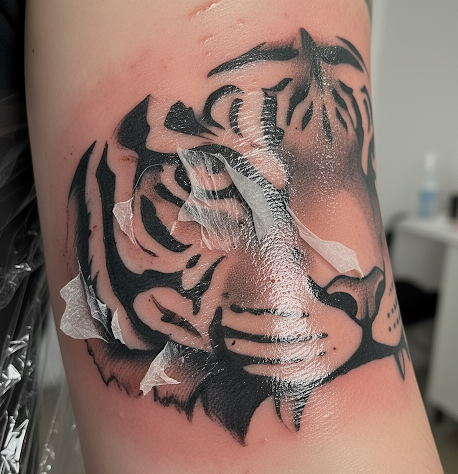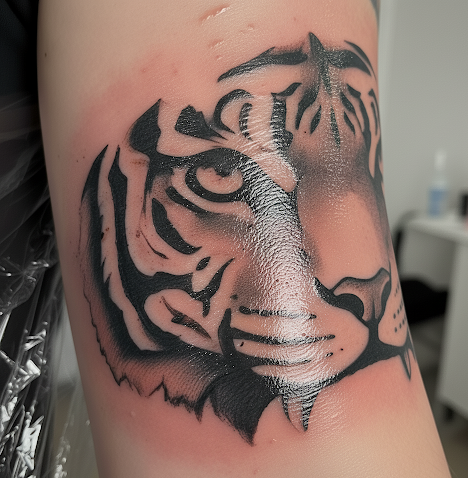Understand the Tattoo Healing Journey
Explore the three phases of tattoo healing, complete with expert tips for effective aftercare and recovery.

Phase One: Initial Healing
Immediately after getting tattooed, your new artwork is essentially an open wound. It will be red, swollen, and might feel warm to the touch. You’ll likely see some weeping or “oozing” of clear plasma, ink, and a small amount of blood. This is the body’s natural response to trauma and the beginning of the healing process. Your artist will typically cover the tattoo with a bandage (cling film or a specialized breathable tattoo film).

Phase Two: Peeling and Flaking
After the initial redness subsides, your tattoo will start to dry out.The scabs will naturally begin to flake and peel off, similar to a sunburn. You’ll see small pieces of colored skin coming off – don’t worry, this is normal and not your tattoo fading! Underneath, the new skin will be shiny, thin, and possibly still a bit tender. The colors might appear slightly dull or cloudy during this phase, which is often called the “milky” or “ghosting” stage. This is because a fresh layer of skin is still growing over the ink.

Phase Three: Settling In
By this stage, all the scabbing and peeling should be complete. The new skin over your tattoo will have fully closed and settled. The tattoo colors will appear vibrant and clear, and the skin should feel smooth and normal to the touch. While the surface layer of skin is healed, the deeper layers can take several months to fully regenerate and for the ink to completely settle.
What to do, Tattoo aftercare:
Discover the aftercare of tattoo healing process, with clear guidance how to care for your new ink.
Phase One: Initial Healing
Keep the initial bandage on as instructed by your artist (usually a few hours for cling film, or a days.
Gently wash the tattoo with unscented, antibacterial soap and lukewarm water. Pat dry with a clean paper towel.
Apply a very thin layer of artist-recommended aftercare ointment.
Avoid direct sunlight, soaking in water, swimming, and tight clothing.
.
Phase Two: Peeling and Flaking
Continue to moisturize regularly. The new skin needs hydration.
Let the skin peel naturally. Do not pull off any flakes or peeling skin.
The itching might continue, but try your best to avoid scratching.
Keep moisturizing to help alleviate the itching and prevent the scabs from cracking
.
Phase Three: Settling In
Continue to moisturize your tattoo regularly as part of your skincare routine.
Always apply sunscreen to your tattoo when exposed to UV rays, as this helps prevent fading.
Your tattoo is now fully healed on the surface! You can resume normal activities like swimming and prolonged sun exposure with protection.
.
What are the key phases of tattoo healing?
Explore detailed answers about tattoo healing stages and effective aftercare tips to aid your recovery.
What happens during the initial tattoo healing stage?
The first stage involves redness, swelling, and scabbing as your skin begins to heal.
How long does the peeling phase last?
Peeling typically occurs between days 3 to 21 as the skin sheds dead cells.
What should I avoid during the healing process?
Avoid sun exposure, scratching, and soaking the tattoo to prevent damage and infection.
When is the tattoo fully healed?
Complete healing can take 2 to 6 weeks, depending on aftercare and skin type.
Begin Your Tattoo Healing Journey Now
Discover the four key stages of tattoo healing and learn expert tips to care for your new ink. Dive deeper to ensure a smooth recovery and vibrant results.
